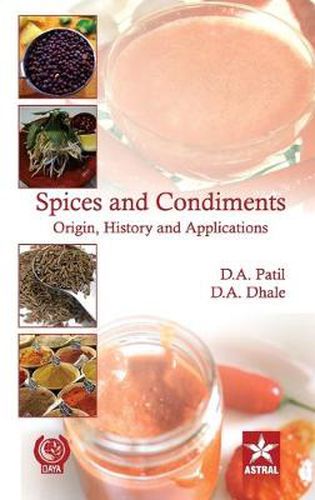Readings Newsletter
Become a Readings Member to make your shopping experience even easier.
Sign in or sign up for free!
You’re not far away from qualifying for FREE standard shipping within Australia
You’ve qualified for FREE standard shipping within Australia
The cart is loading…






This title is printed to order. This book may have been self-published. If so, we cannot guarantee the quality of the content. In the main most books will have gone through the editing process however some may not. We therefore suggest that you be aware of this before ordering this book. If in doubt check either the author or publisher’s details as we are unable to accept any returns unless they are faulty. Please contact us if you have any questions.
After food, medicine and spices of vegetable origin gained prime importance in human life. The spices vis–vis condiments undoubtedly got more currency even in historical times. The history of wars, voyages, travelogues, trades, discovery of new world and water ways, etc. are all replete with references to them. In modern times, their economic significance increased multifold as they are employed not only because of primary functions but also due to their secondary ones. The worldwide demand for processed foods, integral part of modern way of human life, has further geared up their research. In view of all these, the present authors thought worthwhile to write a book encompassing all these aforesaid perspectives. The first chapter of introduction briefly reviews history of spices, their forms and composition, primary and secondary functions. The spices and condiments used world-over are clubbed under 60 titles. An attempt has been made to focus their origin, history, varieties, chemical constituents, properties and multipurpose uses, with particular emphasis on processed products. Fairly vast and relevant bibliography will be useful for all those interested in this plant group. The book is useful to the students, teachers and research workers in botany, plant sciences, agriculture, pharmacy and medicine. It is hoped useful to the industries of food products, perfumery, medicine and agriculture products, apart from academicians engaged in undergraduate and post-graduate studies.
$9.00 standard shipping within Australia
FREE standard shipping within Australia for orders over $100.00
Express & International shipping calculated at checkout
This title is printed to order. This book may have been self-published. If so, we cannot guarantee the quality of the content. In the main most books will have gone through the editing process however some may not. We therefore suggest that you be aware of this before ordering this book. If in doubt check either the author or publisher’s details as we are unable to accept any returns unless they are faulty. Please contact us if you have any questions.
After food, medicine and spices of vegetable origin gained prime importance in human life. The spices vis–vis condiments undoubtedly got more currency even in historical times. The history of wars, voyages, travelogues, trades, discovery of new world and water ways, etc. are all replete with references to them. In modern times, their economic significance increased multifold as they are employed not only because of primary functions but also due to their secondary ones. The worldwide demand for processed foods, integral part of modern way of human life, has further geared up their research. In view of all these, the present authors thought worthwhile to write a book encompassing all these aforesaid perspectives. The first chapter of introduction briefly reviews history of spices, their forms and composition, primary and secondary functions. The spices and condiments used world-over are clubbed under 60 titles. An attempt has been made to focus their origin, history, varieties, chemical constituents, properties and multipurpose uses, with particular emphasis on processed products. Fairly vast and relevant bibliography will be useful for all those interested in this plant group. The book is useful to the students, teachers and research workers in botany, plant sciences, agriculture, pharmacy and medicine. It is hoped useful to the industries of food products, perfumery, medicine and agriculture products, apart from academicians engaged in undergraduate and post-graduate studies.